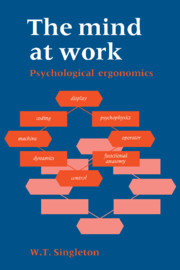1 - HUMAN RESOURCES AND SYSTEM DESIGN
Published online by Cambridge University Press: 22 September 2009
Summary
Concepts
The human contribution
The human role as a system controller
The business of designing machines, processes and systems can be pursued more or less independently of the properties of people. Nevertheless people are always involved, the designer himself is a human being and his product will shape the behaviour of many workers and other users. More fundamentally, the design activity will be meaningless unless it is directed towards serving some human need. In spite of all this, the design process itself is often thought about and executed without any formal considerations about people. Inevitably the engineer, architect or other designer devotes most of his attention and expertise to devising mechanisms, buildings and so on which support some human activity more effectively than those currently available. The new machine or system must not be very different from the old one for a variety of reasons. The old one did its job, not perfectly but well enough to justify its existence. The new one is usually designed on the basis of copying the old one but removing as many as possible of the faults. There are other reasons such as commonality of components and, of course, shortage of imagination which lead to most design and development being a progressive iterative process. This happens to suit the human operators because most of their skills will transfer along the line of development of the machines and systems.
- Type
- Chapter
- Information
- The Mind at Work , pp. 1 - 79Publisher: Cambridge University PressPrint publication year: 1989

